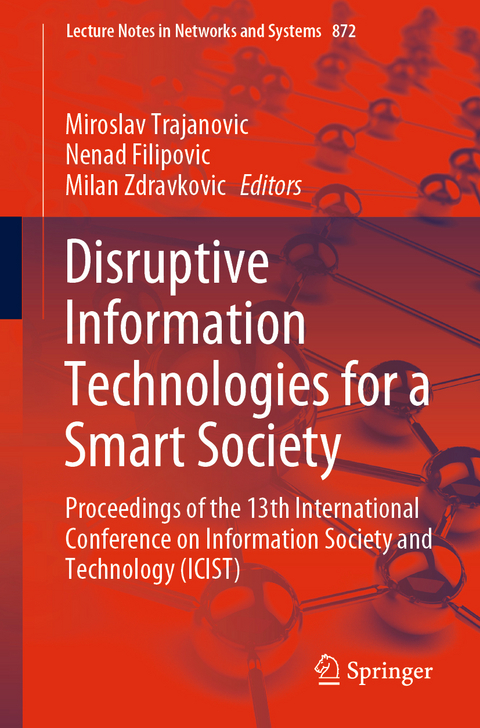
Disruptive Information Technologies for a Smart Society
Springer International Publishing (Verlag)
978-3-031-50754-0 (ISBN)
This book aims at meeting the challenge of getting along with today's unprecedented rate of innovation supported by disruptive digital technologies, which changed the perception of the productivity and effectiveness and opened a gateway to more than ever dynamic advances in solving the important societal challenges.
"Disruptive Information Technologies for a Smart Society" is the proceedings book of the 13th International conference for information society and technologies that brings together experts from various fields to discuss the latest advancements in software engineering, machine learning, digital water, and ICT for health and sport.
The book and the conference serve as a platform for researchers of all career stages in technical sciences, especially Ph.D. students, practitioners, and industry experts in health care, energy, Fintech, AI, and other areas to share and learn on the cutting-edge technologies and stay at the forefront of these rapidly evolving fields.
Part I: ICT for Health, Well-being and Sport.- Prediction of coronary plaque progression using data mining and artificial neural networks.- Rule-Based System For Pregnancy Monitoring.- Finite element analysis of myocardial work in cardiomyopathy.- Saccade Identification During Driving Simulation from Eye Tracker Data with Low-sampling Frequency.- Digital Technologies to support the Decision-Making Process for Dental Implants Treatment Planning.- SGABU Computational Platform as a Tool for Improved Education and Research in Multiscale Modelling.- The Importance of Genetic and Clinical Data features in Risk Stratification of Patients with Hypertrophic Cardiomyopathy.- Haptic user interface for biomechanical feedback in aquatic sports: usability study.- Overview of Deep Learning Retinal Vessel Segmentation Methods from Fundus Images.- Convolutional Neural Network for Atherosclerotic Plaque Multiclass Image Segmentation in Transverse Ultrasound Images of Carotid Artery.- Part II: Applied Artificial Intelligence.- Using AutoML for AI service deployment.- Comparison of Deep Learning Algorithms for Facial Keypoints Detection.- Artificial Intelligence in Public Administration and Business Sector: A Bibliometric Review in Comparative Perspective.- Machine Learning Model as a Service in Smart Agriculture Systems.- A semi-supervised framework for anomaly detection and data labeling for industrial control systems.- Multilingual transformer and BERTopic for short text topic modeling: the case of Serbian.- Evaluation of head-up display for conditionally automated vehicles.- Visual programming support for the explainable artificial intelligence.- Multi-criteria decision making in turning operations using AHP, TOPSIS and WASPAS methods.- CNN-Based Object Detection for Robot Grasping in Cluttered Environment.- Performance Prediction of bio-inspired Compliant Grippers using Machine Learning Algorithms.- Part III:Digital Water.- HPC-based decision support system for remediation works on a dam.- Analysis of seepage through an embankment dam within the framework of hydropower system resilience assessment.- Statistical method for the DDF curves estimation under changing climate.- Technology platform for hydroinformatics systems.- Part IV:Computer Based Learning.- Novel approach for education in biomedical engineering based on atomic learning.- Ontology development approach adopting analogy and competency questions.- Educational system for demonstrating Remote attacks on Android Devices.- CRETE - Code REview Tool for Education.- The architecture of citizen science open data repository based on version control platforms.- Automatic Population of Educational Ontology from Course Materials.- Visual Question Answering - VizWiz challenge.- Part V:Digitalization in Energy sector.- Hybrid Approach in Thermal Demand Forecasting of a Building.- Digital solution to estimate solar power potential of rooftops in city of Belgrade.- Platform for efficient building operation and Demand Response flexibility provision.- Framework for optimizing neural network hyper parameters for accurate wind production forecasting.- Demand-side optimization of hybrid energy systems with heat pumps.- Scalable real-time simulation of electrical power system models in the cloud.- Part VI:Advanced Information Systems.- Relying on E-Contracting and Smart Contracts to Facilitate Legally Enforceable Conformance Checking in Collaborative Production.- Can memes beat the market? A roadmap to forecasting financial asset returns by using social media data and Machine Learning.- Access control in a distributed micro-cloud environment.- E-Government Requirements Specification Based on BPMN.- Towards a Formal Specification and Automatic Execution of ETLs in Cross-Organizational Business Processes.- Task queue implementation for edge computing platform.- Authentication and identity management based on zero trust security model in micro-cloud environment.- Supporting Integrative Code Generation with Traceability Links and Code Fragment Integrity Checks.- Model for Evaluating Points-to Analysis in GraalVM Native Image Using Instrumentation-based Profiling.- A Reference Architecture for Secure IoT.
| Erscheinungsdatum | 04.02.2024 |
|---|---|
| Reihe/Serie | Lecture Notes in Networks and Systems |
| Zusatzinfo | XV, 527 p. 209 illus., 163 illus. in color. |
| Verlagsort | Cham |
| Sprache | englisch |
| Maße | 155 x 235 mm |
| Gewicht | 825 g |
| Themenwelt | Mathematik / Informatik ► Informatik ► Datenbanken |
| Mathematik / Informatik ► Informatik ► Software Entwicklung | |
| Informatik ► Theorie / Studium ► Künstliche Intelligenz / Robotik | |
| Technik | |
| Schlagworte | Blockchain • Computational Intelligence • Digital Healthcare • digital water • machine learning • Software engineering |
| ISBN-10 | 3-031-50754-1 / 3031507541 |
| ISBN-13 | 978-3-031-50754-0 / 9783031507540 |
| Zustand | Neuware |
| Haben Sie eine Frage zum Produkt? |
aus dem Bereich


